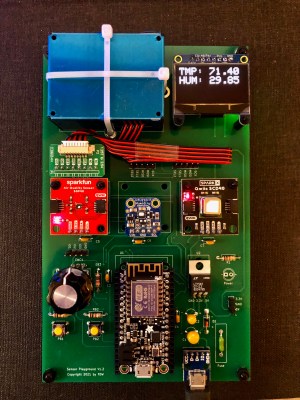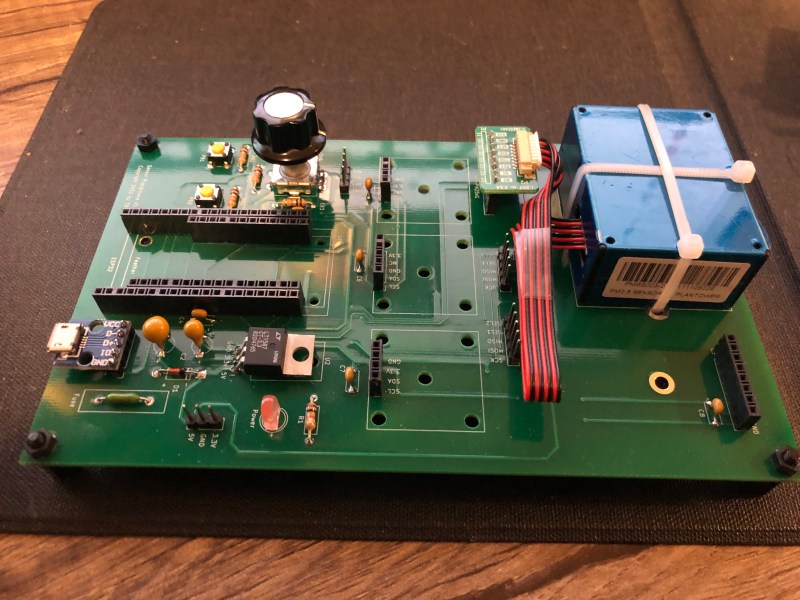When [tdw] wasn’t feeling well one day, his wife suggested that it might be due to poor air quality in their home. While an ordinary person could have simply opened a window after hearing such an idea, [tdw] instead showed his true hacker spirit and set about measuring the indoor air quality. He began by designing a simple PCB to measure CO2 and volatile organic compound (VOC) levels, but eventually broadened his scope to end up with the Sensor Playground: a plug-and-play platform to read out various sensors and store the results in the cloud.
 Deliberately designed to be easy to assemble with minimal soldering skills, the Sensor Playground consists of a big two-layer PCB onto which various modules can be plugged. It supports either an ESP32 DevKit or an Adafruit Feather module to provide processing power, and provides sockets for a bunch of sensors, conveniently wired with power and SPI or I2C. It also provides a rotary encoder and two buttons for user input. All source files are available on [tdw]’s GitHub page, ready to be applied to any kind of sensing task.
Deliberately designed to be easy to assemble with minimal soldering skills, the Sensor Playground consists of a big two-layer PCB onto which various modules can be plugged. It supports either an ESP32 DevKit or an Adafruit Feather module to provide processing power, and provides sockets for a bunch of sensors, conveniently wired with power and SPI or I2C. It also provides a rotary encoder and two buttons for user input. All source files are available on [tdw]’s GitHub page, ready to be applied to any kind of sensing task.
[tdw] set up his Sensor Playground with sensors measuring CO2, VOC, PM2.5 (particulate matter), as well as temperature and relative humidity. A web interface allows anyone to track these measurements in real-time. The open and modular design should make it easy to extend this system with various other sensor types: we can imagine that things like solar irradiation, outside temperature and wind speed would also add useful data to the mix. Perhaps even a Geiger counter to keep track of radiation levels?
As indoor air quality sensors go, this one is definitely comprehensive and easy to use. We’ve featured other air quality sensors before, some of which also link their data to the cloud.
















I mean technically *all* air quality sensors “link their data to the cloud”.
Any way to determine WHAT the pollutants are?
Nah, not important. Just tell everyone the values are plausible and be fine with it. Because after 6 to 12 month, the measurements are sooo way off, it does not matter anyway.
Why will the measurements be way off after some time? Isn’t that sensor a fan and a laser that measures how the light reflects from the air that passes it? Couldn’t you just blow it clear of dust or vacuum it? Or will the measurement be wrong for some other reason than the sensor getting dirty?
I’m under the impression that you can either get dodgy-and-cheap or good-and-expensive air quality sensors.
I mean, in some respect this is true for everything, but my impression is more towards the idea that the is-useful line is much closer to the good-and-expensive side than it is with many other products.
There was supposed to be a question in that comment: “Is my impression correct?”
By coincidence i saw this one recently on youtube: https://youtu.be/esY_OtDLv7g the touchscreen UI is very neat, but it lacks wifi, thought that’s easily fixed of course
This is an interesting fun board and would be a good candidate for ESPHome, and Home Assistant.